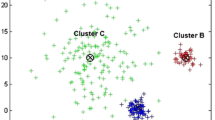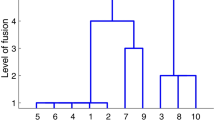Abstract
The TCLUST procedure performs robust clustering with the aim of finding clusters with different scatter structures and weights. An Eigenvalues Ratio constraint is considered by TCLUST in order to achieve a wide range of clustering alternatives depending on the allowed differences among cluster scatter matrices. Moreover, this constraint avoids finding uninteresting spurious clusters. In order to guarantee the robustness of the method against the presence of outliers and background noise, the method allows for trimming of a given proportion of observations self-determined by the data. Based on this “impartial trimming”, the procedure is assumed to have good robustness properties. As it was done for the trimmed k-means method, this article studies robustness properties of the TCLUST procedure in the univariate case with two clusters by means of the influence function. The conclusion is that the TCLUST has a robustness behavior close to that of the trimmed k-means in spite of the fact that it addresses a more general clustering approach.
Similar content being viewed by others
References
Croux C, Filzmoser P, Joossens K (2008) Classification efficiencies for robust linear discriminant analysis. Stat Sin 18(2): 581–599
Cuesta-Albertos JA, Gordaliza A, Matrán C (1997) Trimmed k-means: an attempt to robustify quantizers. Ann Stat 25(2): 553–576
Fraley C, Raftery AE (2002) Model-based clustering, discriminant analysis, and density estimation. J Am Stat Assoc 97(458): 611–631
Gallegos MT (2001) Robust clustering under general normal assumptions. Technical Report MIP-0103, Fakultät für Mathematik und Informatik, Universität Passau
Gallegos MT (2002) Maximum likelihood clustering with outliers. In: Classification, clustering, and data analysis (Cracow, 2002). Studies in classification, data analysis, and knowledge organization. Springer, Berlin, pp 247–255
Gallegos MT, Ritter G (2005) A robust method for cluster analysis. Ann Stat 33(1): 347–380
Gallegos MT, Ritter G (2009) Trimming algorithms for clustering contaminated grouped data and their robustness. Adv Data Anal Classif 3(2): 135–167
García-Escudero LA, Gordaliza A (1999) Robustness properties of k means and trimmed k means. J Am Stat Assoc 94(447): 956–969
García-Escudero LA, Gordaliza A (2007) The importance of the scales in heterogeneous robust clustering. Comput Stat Data Anal 51(9): 4403–4412
García-Escudero LA, Gordaliza A, Matrán C, Mayo-Iscar A (2008) A general trimming approach to robust cluster analysis. Ann Stat 36(3): 1324–1345
García-Escudero LA, Gordaliza A, Matrán C, Mayo-Iscar A (2010) A review of robust clustering methods. Adv Data Anal Classif 4: 89–109
García-Escudero LA, Gordaliza A, Matrán C, Mayo-Iscar A (2011) Exploring the number of groups in robust model-based clustering. Stat Comput 21: 585–599
Hampel FR, Ronchetti EM, Rousseeuw PJ, Stahel WA (1986) Robust statistics. The approach based on influence functions. Wiley series in probability and mathematical statistics: probability and mathematical statistics. Wiley, New York
Hathaway RJ (1985) A constrained formulation of maximum-likelihood estimation for normal mixture distributions. Ann Stat 13(2): 795–800
Luenberger DG, Ye Y (2008) Linear and nonlinear programming. In: International series in operations research and management science, vol 116, 3rd edn. Springer, New York
McLachlan G, Peel D (2000) Finite mixture models. Wiley series in probability and statistics: applied probability and statistics. Wiley-Interscience, New York
Pison G, Van Aelst S (2004) Diagnostic plots for robust multivariate methods. J Comput Graph Stat 13(2): 310–329
Rousseeuw P, van Zomeren B (1990) Unmasking multivariate outliers and leverage points. J Am Stat Assoc 85: 633–651
Ruwet C, Haesbroeck G (2011) Impact of contamination on training and test error rates in statistical clustering analysis. Commun Stat Simul Comput 40: 394–411
Zhong S, Ghosh J (2004) A unified framework for model-based clustering. J Mach Learn Res 4(6): 1001–1037
Author information
Authors and Affiliations
Corresponding author
Rights and permissions
About this article
Cite this article
Ruwet, C., García-Escudero, L.A., Gordaliza, A. et al. The influence function of the TCLUST robust clustering procedure. Adv Data Anal Classif 6, 107–130 (2012). https://doi.org/10.1007/s11634-012-0107-1
Received:
Revised:
Accepted:
Published:
Issue Date:
DOI: https://doi.org/10.1007/s11634-012-0107-1




